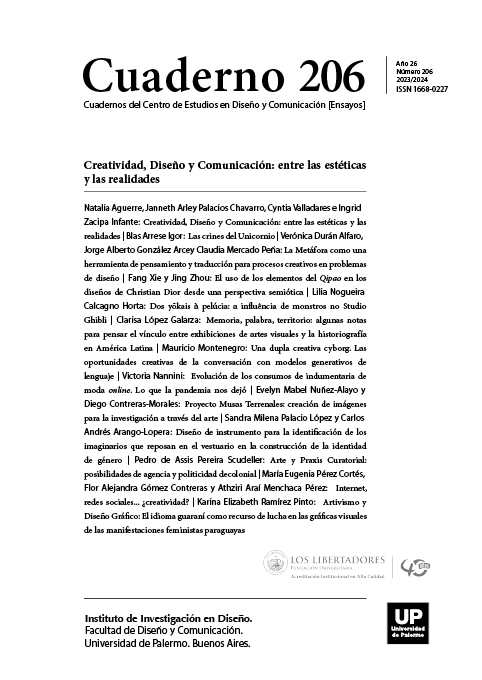Dos yōkais à pelúcia: a influência de monstros no Studio Ghibli
Keywords:
Yōkais, studio Ghibli
Abstract
Studio Ghibli is a Japanese animation studio that has countless fans throughout its history.
References
Cavallaro, D. (2006). The animé art of Hayao Miyazaki. Noth Carolina, US: McFlarland 6 Company, Inc.
Foster, D. (2009) Pandemonium and parade: Japanese monsters and the Culture of Yōkai. Califorina: University of California Press.
Foster, D. (2015). The Book of Yokai: Mysterious Creatures of Japanese Folklore. University of California Press.
Ghibli. (2005-2022). História Do Studio Ghibli. https://www.ghibli.jp/history/.
Horta, L. (2017). Mulheres e memórias em Miyazaki: o consumo da estética híbrida e transgressora do cinema de animação de Hayao Miyazaki. [Disertación]. Escola Superior de Propaganda e Marketing, São Paulo.
Markers, A. (2023). Japanese Yokai and Other Supernatural Beings: Authentic Paintings and Prints of 100 Ghosts, Demons, Monsters and Magicians. Us: Tuttle Publishing.
Mccarthy, E. (1999). Hayao Miyazaki: Master of Japanese Animation. Berkeley US: Stone Bridge.
Miyazaki, H. (1984). Nausicaä del Valle del Viento [Película] Japón: Studio Ghibli.
Miyzakaki, H. (1988). Meu Amigo Totoro. [Película] Japão: Studio Ghibli.
Miyazaki, H. (16 de jul.1995). The Animation of Hayao Miyazaki, Isao Takahata and Studio Ghibli Kinema Junpo Special Issue, Número 1166. em: http://www.nausicaa.net/miyazaki/interviews/m_and_t.html.
Miyazaki, H. (1996). Starting Point. San Francisco US: VIZ Media.
Miyazaki, H. (1997). Princesa Mononoke. [Película] Japão: Studio Ghibli.
Miyazaki, H. (2008). Ponyo: Uma Amizade Que Veio de Mar. [Película] Japão: Studio Ghibli.
Montmayeur,Y. (2005). Ghibli et le mystère Miyazaki [Película televisiva]. Francia: Studio Ghibli, Arte France, Point du Jour production, SBS-TV (Australia) y CNC.
Napier, S. (2001). Anime from Akira to Princess Mononoke: Experiencing Contemporary Japanese Animation. New York: Palgrave.
Odell, C. y Le Blanc, M. (2015). Studio Ghibli: The Films of Hayao Miyazaki and Isao Takahata. Harpenden, UK: Kamera books.
Suzuki, T. (2018). Mixing Work with Pleasure: My Life at Studio Ghibli. Japan: Japan Publishing Industry Foundation for Culture.
Takahata, I. (1988). Túmulo dos vagalumes. [Película] Japão: Studio Ghibli.
Takahata, I. (1994). Pom Poko: a grande batalha dos guaxinins. [Película] Japão: Studio Ghibli.
Takahata, I. (jul 2001). 12th-century moving pictures: Takahata Isao. Japan Quarterly; Tokyo Vol. 48, Ed. 3 p. 31-42.
Tsugata, N. (2013) A Bipolar Approach to Understanding the History of Japanese Animation in Japanese Animation: East Asian Perspectives. (p.25-34). Mississipi, US: University Press of Mississippi.
Yanagita, K. (2013) Yokai DangiPublished by Kadokawa Gakugei Shuppan, Japan.
Foster, D. (2009) Pandemonium and parade: Japanese monsters and the Culture of Yōkai. Califorina: University of California Press.
Foster, D. (2015). The Book of Yokai: Mysterious Creatures of Japanese Folklore. University of California Press.
Ghibli. (2005-2022). História Do Studio Ghibli. https://www.ghibli.jp/history/.
Horta, L. (2017). Mulheres e memórias em Miyazaki: o consumo da estética híbrida e transgressora do cinema de animação de Hayao Miyazaki. [Disertación]. Escola Superior de Propaganda e Marketing, São Paulo.
Markers, A. (2023). Japanese Yokai and Other Supernatural Beings: Authentic Paintings and Prints of 100 Ghosts, Demons, Monsters and Magicians. Us: Tuttle Publishing.
Mccarthy, E. (1999). Hayao Miyazaki: Master of Japanese Animation. Berkeley US: Stone Bridge.
Miyazaki, H. (1984). Nausicaä del Valle del Viento [Película] Japón: Studio Ghibli.
Miyzakaki, H. (1988). Meu Amigo Totoro. [Película] Japão: Studio Ghibli.
Miyazaki, H. (16 de jul.1995). The Animation of Hayao Miyazaki, Isao Takahata and Studio Ghibli Kinema Junpo Special Issue, Número 1166. em: http://www.nausicaa.net/miyazaki/interviews/m_and_t.html.
Miyazaki, H. (1996). Starting Point. San Francisco US: VIZ Media.
Miyazaki, H. (1997). Princesa Mononoke. [Película] Japão: Studio Ghibli.
Miyazaki, H. (2008). Ponyo: Uma Amizade Que Veio de Mar. [Película] Japão: Studio Ghibli.
Montmayeur,Y. (2005). Ghibli et le mystère Miyazaki [Película televisiva]. Francia: Studio Ghibli, Arte France, Point du Jour production, SBS-TV (Australia) y CNC.
Napier, S. (2001). Anime from Akira to Princess Mononoke: Experiencing Contemporary Japanese Animation. New York: Palgrave.
Odell, C. y Le Blanc, M. (2015). Studio Ghibli: The Films of Hayao Miyazaki and Isao Takahata. Harpenden, UK: Kamera books.
Suzuki, T. (2018). Mixing Work with Pleasure: My Life at Studio Ghibli. Japan: Japan Publishing Industry Foundation for Culture.
Takahata, I. (1988). Túmulo dos vagalumes. [Película] Japão: Studio Ghibli.
Takahata, I. (1994). Pom Poko: a grande batalha dos guaxinins. [Película] Japão: Studio Ghibli.
Takahata, I. (jul 2001). 12th-century moving pictures: Takahata Isao. Japan Quarterly; Tokyo Vol. 48, Ed. 3 p. 31-42.
Tsugata, N. (2013) A Bipolar Approach to Understanding the History of Japanese Animation in Japanese Animation: East Asian Perspectives. (p.25-34). Mississipi, US: University Press of Mississippi.
Yanagita, K. (2013) Yokai DangiPublished by Kadokawa Gakugei Shuppan, Japan.
Published
2023-10-19
How to Cite
Calcagno Horta, L. N. (2023). Dos yōkais à pelúcia: a influência de monstros no Studio Ghibli. Cuadernos Del Centro De Estudios De Diseño Y Comunicación, (206). https://doi.org/10.18682/cdc.vi206.10481
Section
Artículos
Los autores/as que publiquen en esta revista ceden los derechos de autor y de publicación a "Cuadernos del Centro de Estudios de Diseño y Comunicación", Aceptando el registro de su trabajo bajo una licencia de atribución de Creative Commons, que permite a terceros utilizar lo publicado siempre que de el crédito pertinente a los autores y a esta revista.


